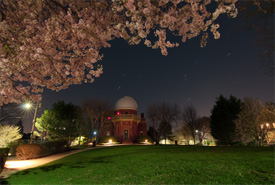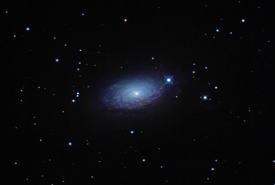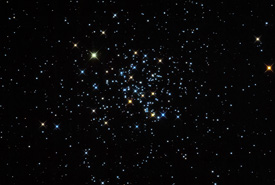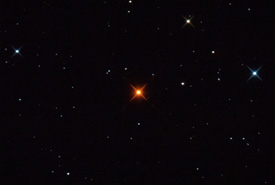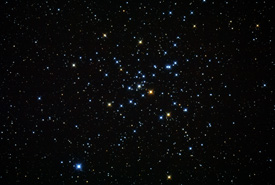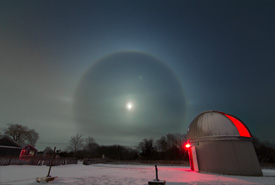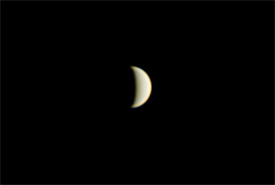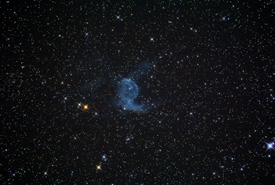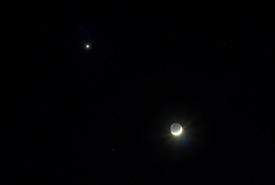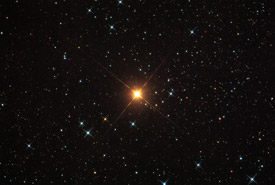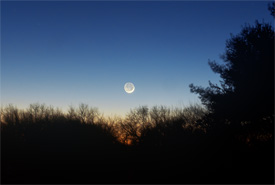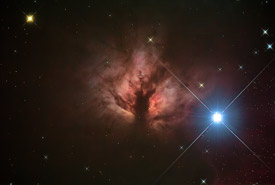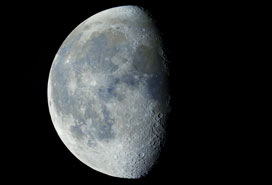
Recent
The Milky Way Returns to Frosty Drew Observatory
After endless cloudy nights since the return of the Milky Way to our Southern New England skies, I finally managed to grab a shot of the Milky Way over Frosty Drew Observatory. I shot this on Wednesday, May 3, 2017 just after 3:00 a.m. The Moon set around 2:30 a.m. and the skies cleared at 3:00 a.m. making for a fabulous view of the Milky Way.
- By: Scott MacNeill
Cherry Blossoms and Star Trails at Ladd Observatory
I captured this shot of the cherry blossoms in bloom under star trails outside Ladd Observatory in Providence, RI on Tuesday, April 18th. Everything worked out nicely for this shot considering I needed clear skies, full cherry blossom bloom, and no wind to pull it off.
- By: Scott MacNeill
The Sunflower Galaxy
This is a shot of Messier 63 - The Sunflower Galaxy. Found in the constellation Canes Venatici, the Sunflower is a spiral galaxy that resides at 27 million light years distant. This is one of the first galaxies to be identified as having a spiral structure.
- By: Scott MacNeill
Messier 67: An Open Star Cluster in Cancer
This is a shot of the Messier 67 Open Cluster. Found in the constellation Cancer, M67 resides at around 2,700 light years distant and is a rather old open star cluster.
- By: Scott MacNeill
R Lepus - Hind's Crimson Star
I captured this shot of R Lepus - Hind's Crimson Star a deep red carbon star that resides approx 1,300 light years distant. Found in the constellation Lepus, the Crimson Star is too dim to spot with the naked eye and may be the deepest red of all stars in our night sky.
- By: Scott MacNeill
Bode's Galaxy: Our Galactic Neighbor
Here's a pleasing shot I captured of Messier 81 - Bode's Galaxy on Tuesday morning, February 21, 2017. Residing at 11.8 light years distant, M81 is part of a galactic group that is the closest neighbor to the Local Group, which is where the Milky Way resides.
- By: Scott MacNeill
Messier 41: An Open Star Cluster in Canis Major
This is a shot of the Messier 41 open star cluster in the constellation Canis Major. Residing at 2,300 light years distant, the relatively small cluster of about 100 stars spans 25 light years in diameter. Under dark skies free of moonlight and light pollution, M41 is barely naked eye visible below the bright star, Sirius.
- By: Scott MacNeill
A Hallowed Penumbral Lunar Eclipse
Last night (February 10, 2017) I was expecting clouds with no eclipse. Instead I got clear skies for the eclipse followed by a 22º halo around the eclipse. Score!
- By: Scott MacNeill
Venus Enters Wanning Crescent
I snapped this shot of Venus just passed third quarter phase on Friday, February 3, 2017. We had a nice layer of heavy haze that dimmed down Venus to the point where a photo was easily captured. Venus put on a fabulous show this winter hanging in the Eastern sky after sunset.
- By: Scott MacNeill
Thor's Helmet
I captured this shot of NGC 2359 - Thor's Helmet Nebula. Residing at 11,960 light years distant, Thor's Helmet contains a Wolf-Rayet star at the center of the 30 light year diameter emissions nebula.
- By: Scott MacNeill
Venus and The 12% Crescent Moon Ring In The New Year
We had fabulously clear skies on New Year's Day in Rhode Island. I spent the night celebrating the New Year with the night sky and captured this shot of Venus and the 12% waxing crescent Moon in a fabulous conjunction.
- By: Scott MacNeill
The Garnet Star
I captured this shot of the Garnet Star, a huge red supergiant star found in the constellation Cepheus. Residing about 6,000 light years distant, the Garnet Star shines 100,000 times brighter than the Sun and is number 21 on the list of largest known stars.
- By: Scott MacNeill
The 2% Waxing Crescent Moon Sets For 2016
I captured this shot of the 2% waxing crescent Moon on Friday afternoon, December 30, 2016. This was the last time we saw the Moon in Rhode Island for 2016.
- By: Scott MacNeill
The Flame Nebula
I captured this shot of NGC 2024 - The Flame Nebula on December 4, 2016. Found just to the side of Alnitak, the left most star in Orion's belt, the Flame contains molecular hydrogen gas that is being ionized by intense ultraviolet light from Alnitak. The Nebula contains a cluster of young stars and resides at 1,350 light years distant.
- By: Scott MacNeill
78% Waning Gibbous Moon in Color
A beautiful, high resolution capture of the 78% waning gibbous Moon from early Saturday morning, November 19, 2016. I shot this on the Frosty Drew Observatory 16" SCT at 4000mm. The image is a 7 panel panoramic with each panel comprised of 15 sub images composited. Blue regions contain high deposits of titanium, where red regions are iron poor.
- By: Scott MacNeill

